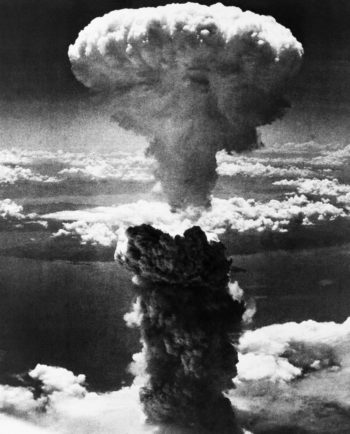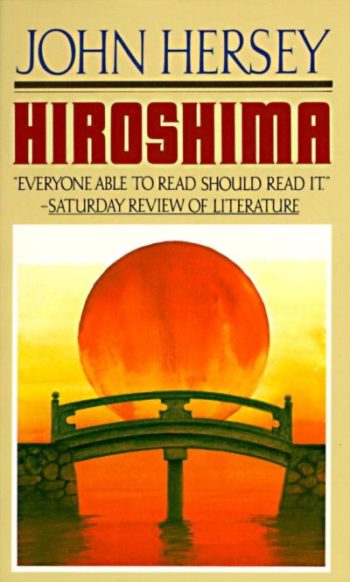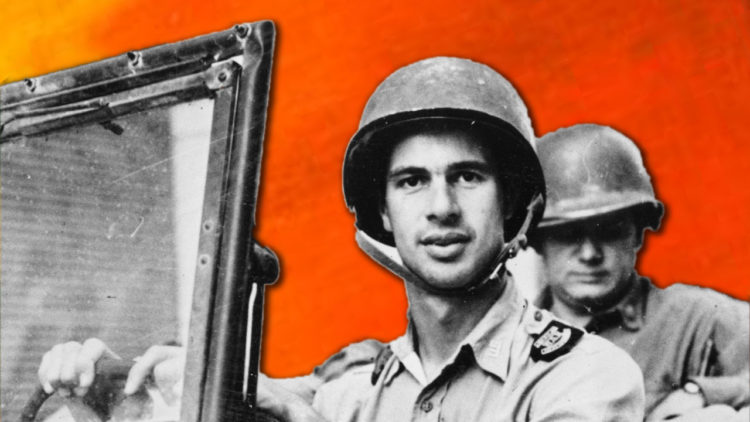Seventy-five years ago, on Aug. 6, 1945, a plane called the Enola Gay, manned by a crew from the U.S. Army Air Force, flew over the Japanese city of Hiroshima and dropped the world’s first atomic bomb. The bomb had a name: Little Boy. So did the second bomb that was dropped three days later on Nagasaki: Fat Man. The estimated 120,000 Japanese who were killed instantly in the two attacks had names, too, as did the tens of thousands more who died from the fallout in the weeks and months afterwards. It is doubtful any of those names were known to the young Americans ordered to facilitate those deaths. Their job was to bring an end to World War II.
Seventy-one years ago today, on Aug. 6, 1949, my oldest brother was born. He was the first of five of us. Our father was, from what little I can glean, in the Army Air Force, stationed somewhere in the Pacific Theater. I have no idea what he did during the war, or where he was when the bombs were dropped. He was of that cohort of young men who answered the call to war, came home, got married, got a job, raised a family — and put a cap on the bottle of whatever had happened in the theater of battle. My brother’s name was Greg.

Even as a young girl, I knew about the atomic bomb. Or at least that there had been one, and we didn’t want there to be another. I was not only the child of a WWII veteran, but of the Cold War. Duck-and-cover drills in elementary school. The hushed conversations of adults during the Cuban missile crisis. The terrifying Daisy Girl ad, in which Lyndon Baines Johnson used the threat of nuclear war to defeat conservative — some would say war-mongering — Senator Barry Goldwater in 1964 to continue the presidency he inherited when John F. Kennedy was assassinated. The wallpaper of my childhood carries the stamp of a mushroom cloud. And every Aug. 6, as my mother and I frosted my brother’s birthday cake, the daily newspaper landed in the driveway with the inevitable headline about the anniversary of Hiroshima, much as every December 7, it brought us a reminder of Pearl Harbor.
These memories lead down a long hallway lined with doors, each door opening to stories, which always open to more doors and more stories. One of those rooms I always stop at is my brother’s. He has been gone 24 years now, killed by a distracted teenaged driver. I hunted down the kid’s name after the accident; I always wondered if he bothered to learn my brother’s.
But today, in this setting and for this community, I want to stop at a door that opens to journalism, and to another name: John Hersey. For all of those personal connections to the anniversary of Hiroshima — and despite a kick-ass high school history teacher — it was Hersey’s book of the same name that stays with me, and that I return to year after year.
Learning from the “first nonfiction novel”
“Hiroshima” sits on a shelf in my makeshift home office with dozens of other books about and of journalism. But it has the distinction of being one of a handful I consider must-reads for anyone who wants to do this work. I have no idea when I first read it, except that it was far too late in my career. (Why wasn’t it required reading when I was in journalism school in the 1970s? Was everyone too distracted by Vietnam and Watergate? Is everyone today too distracted by politics and the pandemic to deliver what would normally be an endless march of headlines for an anniversary of this magnitude?) I do remember the opening passage, which introduces six characters in brief work-a-day scenes just as the bomb drops. That passage is one long paragraph, launched with a clause — actually a series of clauses — before the first character is introduced:
At exactly fifteen minutes past eight in the morning, on August 6, 1945, Japanese time, at the moment when the atomic bomb flashed about Hiroshima …
The passage ends in that same, single paragraph, with no more than a period separating the characters and the foreshadow of the unimaginable events to come:
A hundred thousand people were killed by the atomic bomb, and these six were among the survivors. They still wonder why they lived when so many others died. Each of them counts many small items of chance or volition—a step taken in time, a decision to go indoors, catching one streetcar instead of the next—that spared him. And now each knows that in the act of survival he lived a dozen lives and saw more death than he ever thought he would see. At the time, none of them knew anything.
At that point, I knew just one thing: I had to know more. And as I read on, it became clear: This was how journalism was done. Or, more to the point, how it should be done.
“Hiroshima” is a portable masterclass in history, humanity and journalism. The New Yorker published the original version, structured in four chapters, as a single take in August, 1946; it remains the only story that was granted an entire edition of the magazine. This week, the New Yorker reposted it online, along with the “Aftermath,” which Hersey added in 1985 after he followed up on the fate of his six characters, and a small collection of related stories. Among them, “John Hersey and the Art of Fact,” in which Nicholas Lemman, emeritus dean of the Columbia School of Journalism, profiles Hersey as pioneering a new form of journalism while adhering to a “sacred” rule: “The writer must not invent.” From Lemman’s piece:
“Hiroshima” is told entirely in an unadorned, omniscient third-person voice, which is why it’s often called the first nonfiction novel.
Hersey apparently considered himself a novelist more than a journalist — he won a Pulitzer for his World War II tale, “A Bell for Adano.” But the tributes and profiles I’ve read tend to cite his unflinching, unembellished journalism — which may have been an extension of his personality.
Nonfiction author Peter Richmond (Nieman class 1989) stumbled his way into a senior writing seminar taught by Hersey at Yale some 40 years ago. In a 2013 essay for Storyboard, Richmond recalled the first thing Hersey said to 12 awed and still-arrogant young writers: “If anyone in the room thinks of himself or herself as an artist, this is not a course for you. I teach a craft.” Storytelling as craft! How humbling — and how bold. Richmond struggled through the semester, but left with wisdoms he’s clung to ever since. Among them:
- In good fiction, the reader absorbing a compelling narrative never notices the writer as intermediary. In nonfiction, that translator’s presence is inevitable.
- Let the story, invented fictitiously or real-world, speak for itself.
- Editors are there for a reason: not because they aren’t good writers, but because they are very good at what they do.
- If what you leave out is essential, then the details you choose to leave in must be essential.
- Never veer far from the story.
I expect it would be hard to find a successful narrative journalist who hasn’t been influenced by Hersey, whether directly or through some force of the cosmos. Pulitzer winner Mark Bowden surely is one of them. The former Philadelphia Inquirer reporter busted into a career of books and movies with “Black Hawk Down,” the harrowing account of 18 Army Rangers killed during a failed raid on warlords in Somalia in 1993. Bowden was teaching journalism in 2012 when Paige Williams, then the editor of Storyboard, asked a few of us what we included on our course reading lists. Bowden cited “Hiroshima:”
…because of its historical importance in the genre of literary nonfiction, because of its relative simplicity as a piece of reporting and writing, and because it is a powerful and compelling read. Hersey illustrates the importance of asking, “Who and what, at the most basic level, is this story about?” In the case of the atom bomb, it was the one piece of the story that had not been reported — and which was the most important.
I had “Hiroshima” on my syllabus, too. This is what I wrote in that same Storyboard piece:
I have found nothing that better demonstrates the reporting that is both required and possible for powerful literary nonfiction. We analyze what Hersey would have had to notice and ask to reconstruct such precise, vivid and credible scenes. As for the writing, it is a study in simplicity. Hersey uses verbs that are strong but seldom flashy, sentences that are tight and direct, and a minimum of embellishment to let the raw drama of the narrative come through.
If I were still in the classroom, I might ask today’s students to pitch how they would cover the same story with multi-media tools. What reach and layering might be gained? What purity and power might be lost?
The need to name — and remember

I thumbed through “Hiroshima” again this week. It is no fancier than a few thousand words on a few dozen pages; there aren’t even any still photos. But it has lost none of its power. And that power comes from the purity of Hersey’s reporting. Being able to make words dance is fine, even enviable. But it is the reporting that makes the music. Hersey’s music is composed of a limited selection of characters for the readers to follow, and then a disciplined structure of chronological scenes. He moves forward through the days as each of the characters did, often in the same order in which he introduced them on the opening page. He lets what is happening in those scenes open to broader context and explanation, but never at a length or in a language that interrupts the forward trajectory. The tone is tense – not because of twirls and trickery, but because of the leanness and precision of Hersey’s language. What adjectives are there are doing hard and necessary work.
This time, something else struck me in a new light: The names.
Getting the names of our story subjects and sources is more than pro forma journalism; it is the prime directive. That can be hard to explain to those we interview, or even to the public, which is quick to judge our invasiveness. But names — real names, spelled correctly — stand as a bulwark between credible journalism and the temptations of shortcuts. Even in the limited circumstances when we don't use them, we need to know them. As much as anything we do, names matter.
Greg. Not just a traffic fatality, but a remembered son, brother, husband and father.
The Enola Gay. Little Boy. Fat Man. Not just equipment, but remembered instruments of both destruction and salvation.
Hatsuyo Nakamura, Dr. Terufumi Sasaki, Father Wilhelm Kleinsorge, Toshiko Sasaki, Dr. Masakaza Fujii, Kiyoshi Tanimoto. Not just convenient fictions for conflated events, but real people. As much as they shared a common event, their travails and triumphs were unique. By honoring each of them for who they were and what they went through, Hersey honored every victim of Hiroshima and Nagasaki. They were the survivors who lived to tell the tale we need to remember.



